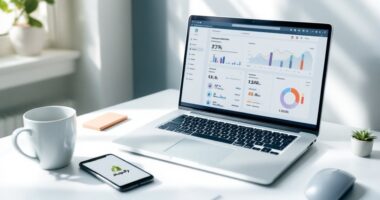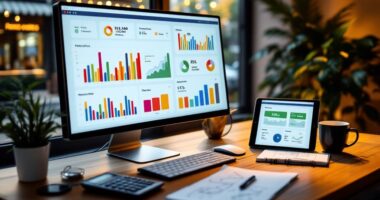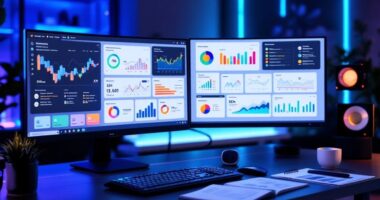Fixed asset software helps small businesses track equipment, property, and other valuable assets while automating depreciation calculations and maintenance schedules. Popular solutions like Asset Tiger and Asset Panda offer user-friendly interfaces, mobile access, and integration with existing accounting systems. These tools reduce manual errors, guarantee tax compliance, and provide real-time insights into asset value and performance. Key features include barcode tracking, customizable reporting, and cloud-based accessibility. The right software choice depends on specific business needs, growth plans, and budget considerations.
Quick Overview
- Asset Tiger and Asset Panda are top solutions specifically designed for small businesses with user-friendly interfaces and mobile accessibility.
- Cloud-based fixed asset software eliminates the need for expensive IT infrastructure, making it ideal for small business budgets.
- Automated depreciation calculations and maintenance scheduling prevent costly errors and extend equipment life for resource-conscious small businesses.
- Integration capabilities with common accounting systems ensure smooth data flow without requiring complex technical expertise.
- Small businesses benefit from real-time asset tracking and customizable reporting features that support growth without overwhelming operational resources.
Understanding Fixed Asset Software Essentials
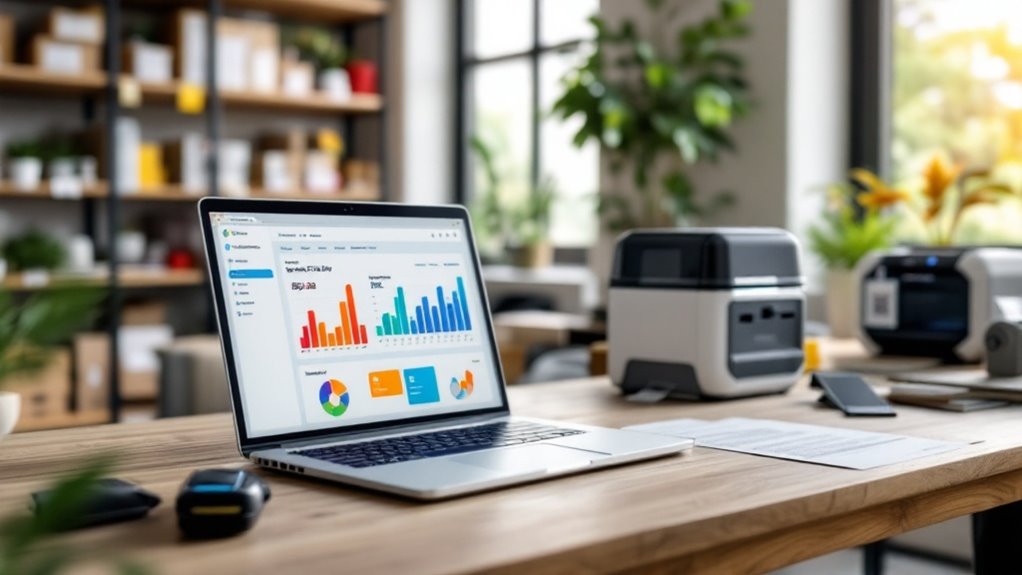
Modern businesses require efficient tools to manage their valuable assets, and fixed asset software serves as the cornerstone of effective asset management. This specialized technology streamlines the tracking and maintenance of both tangible and intangible business assets while automating essential processes like depreciation calculations.
At its core, fixed asset software delivers real-time insights into asset value and lifecycle management through features like barcode tracking, maintenance scheduling, and automated reporting. The system’s integration capabilities allow seamless connection with existing accounting and ERP systems, ensuring accurate financial records. The software enables businesses to track property, plant, and equipment efficiently through comprehensive monitoring systems.
For small businesses, the software proves particularly valuable by preventing manual errors, maintaining compliance with tax regulations, and providing clear visibility into asset performance. This thorough approach helps companies make informed decisions about their investments while saving time and reducing operational costs.
Benefits That Drive Business Growth
Building on the foundations of fixed asset software functionality, businesses can free up multiple advantages that fuel their growth and success. These solutions deliver measurable improvements across operations, compliance, and financial planning. The software’s automated features reduce errors while saving valuable time and resources. Smart tracking systems help protect critical business data and minimize asset loss risks through advanced monitoring capabilities.
| Benefit Area | Key Advantage | Business Impact |
|---|---|---|
| Compliance | Automated Calculations | Reduced Audit Risk |
| Operations | Streamlined Workflows | Enhanced Productivity |
| Financial | Real-time Tracking | Better Decision Making |
| Growth | Scalable Solutions | Future-proof Investment |
Small businesses particularly benefit from improved accuracy in depreciation calculations, reduced maintenance costs, and enhanced asset lifecycle management. The centralized platform guarantees consistent data access while supporting strategic planning through detailed analytics and reporting capabilities. These advantages position organizations for sustainable growth and improved competitive standing in their markets.
Must-Have Features and Capabilities
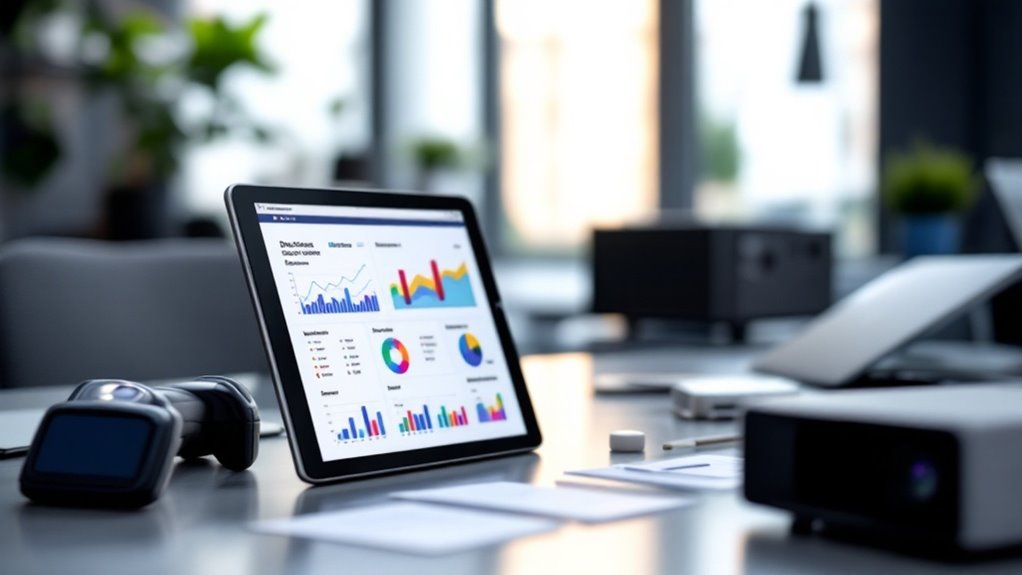
Every successful fixed asset software solution must incorporate several essential features to deliver maximum value for businesses. The core capabilities include automated depreciation calculations that guarantee accurate financial reporting while supporting various depreciation methods. Robust asset tracking features, using RFID tags or barcodes, provide real-time monitoring of both physical and digital assets.
Comprehensive maintenance scheduling tools help prevent equipment breakdowns and extend asset life through proactive management. The software should seamlessly integrate with existing business systems while offering scalability for future growth. Additionally, strong reporting functions generate customizable financial reports and maintain audit-ready records for compliance purposes. These features work together to create a complete asset management solution that streamlines operations, reduces costs, and guarantees regulatory compliance. Modern solutions like Asset Panda integrate mobile capabilities that enable efficient tracking through smartphone applications.
Top Software Solutions in the Market
Five leading fixed asset software solutions have emerged as industry frontrunners, each offering distinct advantages for businesses seeking thorough asset management. These solutions provide essential tools for tracking, depreciation, and compliance needs. The integration with accounting systems and workflows helps reduce manual data entry errors and streamlines financial reporting processes.
| Software | Key Strength | Best For |
|---|---|---|
| Sage Fixed Assets | Advanced depreciation methods | Complex accounting needs |
| Asset Tiger | User-friendly mobile access | Small team operations |
| Asset Panda | Customizable reporting | Growing businesses |
| Numeric | Automated workflows | Financial compliance |
| Asset.Guru | MRO tracking | IT and real estate |
Each platform brings unique capabilities to the table. Sage Fixed Assets excels in depreciation management, while Asset Tiger focuses on accessibility. Asset Panda offers scalability, Numeric emphasizes automation, and Asset.Guru specializes in maintenance tracking. These differences allow businesses to choose a solution that aligns with their specific requirements and growth plans.
Making the Right Investment Decision

With several leading software solutions available in the market, organizations must carefully evaluate their options before making a financial commitment to fixed asset software. Companies should assess their specific needs, budget constraints, and long-term growth plans to select the most suitable solution. For optimal results, implementing a comprehensive asset policy helps guide decisions throughout the software selection and utilization process.
Making an informed software choice requires thorough evaluation of current needs and future goals before committing to a fixed asset solution.
The decision-making process requires thorough research and consideration of key factors.
- Core features must align with business requirements, including automated depreciation calculations, asset tracking, and maintenance scheduling.
- Integration capabilities should guarantee seamless data flow between existing systems and new software.
- Implementation costs and potential ROI need careful evaluation, considering both immediate expenses and long-term benefits.
- Security measures and compliance tools must meet industry standards to protect sensitive financial data and maintain regulatory adherence.
Implementation and Best Practices
Successful implementation of fixed asset software requires a structured approach and adherence to proven best practices. Small businesses can achieve smooth integration by focusing on key implementation elements that guarantee long-term success.
The process begins with selecting user-friendly software that offers detailed training and support. Cloud-hosted solutions, particularly those using platforms like Microsoft Azure, eliminate the need for complex IT infrastructure. Integration with existing accounting systems, such as Sage or Microsoft Dynamics, helps maintain data consistency and reduces duplicate entries. A comprehensive system should include serial numbered tags to efficiently identify and monitor business assets.
To maximize benefits, businesses should utilize pre-configured templates for asset categorization and take advantage of automated compliance features. Regular staff training and standardized procedures confirm proper usage, while customizable reporting options allow the software to grow alongside the business, accommodating both current and future asset management needs.
Frequently Asked Questions
Can Fixed Asset Software Handle Multiple Currencies for International Business Operations?
Yes, modern fixed asset software effectively handles multiple currencies for international operations.
These systems automatically convert transactions between currencies, maintain up-to-date exchange rates, and track foreign exchange gains and losses.
They provide thorough multi-currency reporting capabilities, ensuring accurate financial records across borders.
The software typically includes automated currency conversion tools, exchange rate management features, and compliance support for international accounting standards.
What Happens to Asset Data if the Software Company Goes Out of Business?
When a software company goes out of business, asset data accessibility depends on several key factors. Typically, clients retain ownership rights to their data, but retrieval can be challenging.
Companies should protect themselves by:
- Regularly exporting data to accessible formats
- Maintaining local backups
- Ensuring service agreements include data portability clauses
In bankruptcy scenarios, administrators may help facilitate data recovery, or clients might need legal assistance to secure access to their information.
Cloud-based solutions often provide better protection against vendor shutdowns.
How Often Should Businesses Conduct Physical Asset Verification With the Software?
Businesses should conduct physical asset verification at least annually, though the ideal frequency depends on several factors. High-value or mobile assets may require quarterly checks, while standard equipment can follow annual schedules.
Software-assisted verifications can be performed more frequently due to their efficiency, typically reducing verification time by 70%. Many organizations implement a hybrid approach: annual thorough counts supplemented with quarterly spot checks for critical assets.
Can the Software Track Assets That Are Temporarily Loaned to Other Companies?
Yes, fixed asset software effectively tracks temporarily loaned assets to other companies. The software includes dedicated features like check-out systems, due date monitoring, and automated alerts for overdue returns.
It maintains detailed records of asset movements, including who borrowed what and when items should be returned. Through cloud-based tracking, businesses can monitor their loaned assets in real-time, ensuring proper accountability and reducing the risk of loss or misplacement.
Is It Possible to Transfer Asset Data When Switching Between Different Software Platforms?
Yes, transferring asset data between different software platforms is possible through several methods. Most modern systems support data migration using standardized formats like CSV, XML, or through API integrations.
Software providers typically offer migration tools and support services to facilitate smooth changes. While some compatibility challenges may arise, pre-built templates and data validation processes help maintain accuracy. Many platforms include built-in import/export features specifically designed for effortless data transfer to verify the integrity of the process.
Conclusion
Fixed asset software represents a worthwhile investment for small businesses seeking to streamline their operations and maintain financial clarity. While the initial adjustment period may present temporary challenges, the long-term advantages of automated tracking, improved accuracy, and simplified compliance make the changeover incredibly valuable. By carefully selecting and implementing the right solution, small businesses can transform their asset management from a manual burden into a strategic advantage.


